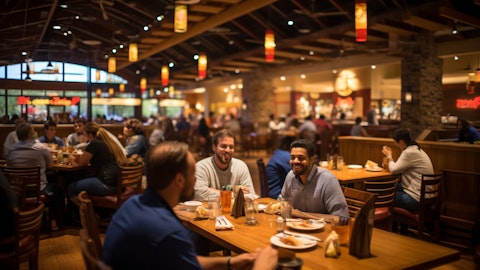Texas Roadhouse, Inc. (NASDAQ:TXRH) Q4 2023 Earnings Call Transcript February 15, 2024
Texas Roadhouse, Inc. beats earnings expectations. Reported EPS is $1.08, expectations were $1.07. Texas Roadhouse, Inc. isn’t one of the 30 most popular stocks among hedge funds at the end of the third quarter (see the details here).
Operator: Good evening, and welcome to the Texas Roadhouse Fourth Quarter Earnings Conference Call. Today’s call is being recorded. All participants are now in a listen-only mode. After the speakers’ remarks, there will be a question-and-answer session. [Operator Instructions] I would now like to introduce Michael Bailen, Head of Investor Relations for Texas Roadhouse. You may begin your conference.
Michael Bailen: Thank you, Rob, and good evening. By now, you should have access to our earnings release for the fourth quarter ended December 26, 2023. It may also be found on our website at texasroadhouse.com in the Investors section. I would like to remind everyone that part of our discussion today will include forward-looking statements. These statements are not guarantees of future performance, and therefore, undue reliance should not be placed upon them. We refer all of you to our earnings release and our recent filings with the SEC. These documents provide a more detailed discussion of the relevant factors that could cause actual results to differ materially from those forward-looking statements. In addition, we may refer to non-GAAP measures.
If applicable, reconciliations of the non-GAAP measures to the GAAP information can be found in our earnings release. On the call with me today is Jerry Morgan, Chief Executive Officer of Texas Roadhouse; and Chris Monroe, our Chief Financial Officer. Following the prepared remarks, we will be available to answer your questions. In order to accommodate everyone that would like to ask a question, we kindly ask analysts to please limit yourself to one question. Now I would like to turn the call over to Jerry.
Jerry Morgan: Thanks, Michael, and good evening, everyone. 2023 was another great year for Texas Roadhouse. We generated over $4.6 billion in revenue and increased average unit volumes to over 7.6 million at Texas Roadhouse. And for the full year, comp sales grew over 10%, with more than half of that increase coming from higher guest traffic. Along with this top line growth, we also reported double-digit increases in restaurant margin dollars, income from operations and earnings per share for full year 2023. Our results clearly reflect the commitment our managing partners have in taking care of their guests and their communities. There are no better examples of this passion than our Veterans Day celebration and our national fundraiser to benefit tinnitus research.
On Veterans Day, we honored nearly 700,000 veterans by providing a free meal or voucher for a future meal. And just over a week ago, we raised over $925,000 for the American Tinnitus Association, in honor of our late founder, Kent Taylor. These are just two of the many ways our operators give back to their local communities. 2023 was a record year for system-wide new store openings. For the full year, we opened 30 company restaurants across all brands. And our franchise partners opened 15 restaurants, including our first two franchised Jaggers. For 2024, we continue to expect to open approximately 30 company-owned restaurants across the three brands. Our expectation is that this year’s openings will be more evenly distributed throughout the year as compared to last year, when 50% of our openings occurred in the last four months.
Additionally, we expect our franchise partners will open as many as 14 international and domestic locations, including four Jaggers. In 2024, we will also maintain our emphasis on operational efficiencies and improving the guest and employee experience by focusing on technology investments. Based on positive feedback from our operators, we’re accelerating the number of digital kitchen conversions to be completed this year. We now expect to convert approximately 200 existing Texas Roadhouses to a digital kitchen in 2024. And we have also standardized this equipment for new openings at all three brands. We are also focused on increasing guest awareness of our digital platform, which is the most efficient way for our guests to put their names on the waitlist, to dine in our restaurants and to place their to-go orders.
In closing, we are extremely excited about the direction of our business and our three brands. There are so many things to be proud of, but at the same time, we still have many opportunities to continue building our business going forward. Now Chris will provide some thoughts.
Chris Monroe: Thanks, Jerry. 2023 was certainly an impressive year. Our restaurants are the busiest they’ve ever been, but our operators are focused on serving even more guests on every shift. Of course, we expect to continue to face inflationary pressures in 2024, albeit at a lower rate than we have experienced the last several years. Cattle supply will continue to be a challenge in 2024. However, we now expect the majority of the financial impact of this tightening supply to be in the back half of 2024. As such, we are updating our full year 2024 commodity inflation guidance to approximately 5%, from between 5% and 6%. On the labor side, our guidance for wage and other labor inflation remains unchanged at between 4% and 5%.
To help offset the impact of inflationary pressures, we will be implementing a 2.2% menu price increase at the beginning of our second quarter. As we typically do, we partnered with our operators to determine the appropriate amount of pricing for each of our restaurants. This process includes looking at traffic trends, state-mandated wage increases and local labor trends as well as comparing our prices to those of other restaurants in their specific community. This level of detail and operator involvement provides us with the confidence that we are taking the right level of pricing without sacrificing our value proposition. As Jerry mentioned, we opened 30 company-owned restaurants in 2023, which included 22 Texas Roadhouses, five Bubba’s 33s and three Jaggers.

While sales volumes at new Texas Roadhouse restaurants increased, so did the average investment cost in 2023. Part of this was the inflationary pressure on building costs that the industry faced in 2023. But it was also due to our strategic investment in building a larger prototype to be able to serve even more guests. The addition of dedicated to-go areas and more back-of-house space needed to serve higher guest volumes has increased the size of the current prototype by approximately 10% from our pre-COVID prototype. Returns on investment for our portfolio of new restaurants continue to exceed both our cost of capital and our targeted mid-teen IRR. Before we fully shift our attention to 2024, it’s important to recognize the financial accomplishments we had in 2023.
We ended the year with $104 million in cash and generated $565 million of cash flow from operations. With this cash flow, we self-funded $347 million of capital expenditures as well as the $39 million acquisition of eight franchise restaurants. We also returned over $147 million to our shareholders in the form of dividends, completed $50 million of share repurchases and repaid the final $50 million of bank debt that we borrowed at the onset of COVID. In 2024 and beyond, we will continue to make meaningful capital investments in existing restaurants as well as new restaurant development. At this time, our capital expenditure guidance for 2024 remains unchanged at between $340 million and $350 million. As always, investments will be evaluated to ensure we continue to put our capital to work where we create the greatest shareholder value.
Overall, our shareholders were rewarded in fiscal year 2023, with EPS growth of 14.3% and a dividend yield of 2.1%. This total return of 16.4% is consistent with our average return over the past 10 years. With a disciplined approach to capital allocation and the excellent results, we expect our operators to continue generating, we are confident that we can continue to reward our investors with strong returns for years to come. And now Michael will walk us through the quarter results and provide additional 2024 guidance.
Michael Bailen: Thanks, Chris. For the fourth quarter of 2023, we reported revenue growth of 15.3%, driven by a 9.3% increase in average unit volume and 6.1% store week growth. We also reported a restaurant margin dollar increase of 21.4% to $177 million, and a diluted earnings per share increase of 21.3% to $1.08. Average weekly sales in the fourth quarter were over $141,000, with to-go representing approximately $18,000 or 12.6% of these total weekly sales. At this time, to-go has already become, on average, a $1 billion business per restaurant, with additional room for growth. Comparable sales increased 9.9% in the fourth quarter, driven by 5.1% traffic growth and a 4.8% increase in average check. By month, comparable sales grew 9.2% in both October and November and 11.1% in December.
And while weather has negatively impacted our year-to-date 2024 sales, comparable sales are still up 6.8%, including 3% traffic growth for the first 50 days of the year, with our restaurants averaging sales of approximately $155,000 per week during that time frame. In the fourth quarter, restaurant margin dollars per store week increased to over $21,600. And restaurant margin as a percentage of total sales increased 75 basis points year-over-year to 15.3%. Food and beverage costs as a percentage of total sales were 34.2% for the fourth quarter, the 88 basis point year-over-year improvement was driven by the benefit of a 4.8% check increase, offsetting the 3.2% commodity inflation for the quarter. Commodity inflation for full year 2023 was 5.6%, which was the midpoint of our guidance.
Labor as a percentage of total sales decreased 28 basis points to 33.1% as compared to the fourth quarter of 2022. Labor dollars per store week increased 7.9% due to wage and other labor inflation of 5.5% and growth in hours of 2.4%. For the full year, wage and other labor inflation came in at 6.6%, which was the midpoint of our 2023 guidance. As Chris mentioned, we continue to expect wage and other labor inflation of between 4% and 5% in 2024. Included within this guidance is approximately $3 million of additional labor expense in the second half of 2024, from enhancements to our equity compensation program, including a moving from quarterly to annual grants. Other operating costs were 15.8% of sales which was 49 basis points higher than the fourth quarter of 2022.
Included in the year-over-year change is in an approximately 40 basis point negative impact from adjustments to our quarterly reserve for general liability insurance. These adjustments include $3.7 million of additional expense this year and a $0.9 million credit last year. Moving below restaurant margin, G&A dollars grew 23.3% year-over-year and came in at 4.3% of revenue for the fourth quarter. The primary driver of the year-over-year increase was higher cash and equity compensation. For 2024, the equity grant enhancement will also add approximately $3.5 million of G&A expense in the second half of the year. Our effective tax rate for the quarter was 10.9%. Our full year 2023 income tax rate of 12.5% was below our guidance due to a lower than anticipated state tax rate.
And we are updating our expectation for the full year 2024 income tax rate to approximately 14%. Finally, as we reminded everyone last quarter, 2024 is a 53-week year for us. As such, the fourth quarter will have 14 weeks versus our normal 13 weeks. We estimate that the additional week could benefit full year 2024 earnings per share growth by approximately 4%. Now, I will turn the call back over to Jerry for final comments.
Jerry Morgan: Thanks, Michael. There’s no question 2023 was another legendary year for Texas Roadhouse and we are looking forward to building on our momentum into 2024. As always, we will be focused on driving sales, controlling costs, taking care of our people and maximizing shareholder value. We are also looking forward to our upcoming Managing Partner Conference in Austin, Texas, where we will be celebrating all of our amazing partners. Additionally, we will be naming our Annual Managing Partner of the Year for Texas Roadhouse and our second ever Bubba’s 33 Managing Partner of the Year. I’m very proud of our accomplishments and even more excited for our future. It’s a great time to be a roadie at Texas Roadhouse. That concludes our prepared remarks. Operator, please open the line for questions.
See also 15 Best Hospitals for Cancer Treatment in the US and 20 Cities With The Highest Cost of Living in the US.
Q&A Session
Follow Texas Roadhouse Inc. (NASDAQ:TXRH)
Follow Texas Roadhouse Inc. (NASDAQ:TXRH)
Operator: [Operator Instructions] Your first question comes from the line of Jeffrey Bernstein with Barclays. Your line is open.
Jeffrey Bernstein: Great. Thank you very much. I had two questions. The first one just thinking about the 2024 restaurant margins, it’s pretty impressive. You nailed the cost outlook in 2023 in terms of the ranges you provided for COGS and labor. If you were to do the same in 2024, and obviously you gave us the inflation guidance you expect at this point. But if you came in within those ranges, can you talk about the potential restaurant margin expansion outcomes or maybe the range of outcomes you could see or what you think would be the greatest unknowns in terms of that restaurant margin? And then I had one follow-up.
Michael Bailen: Yes. Hi, Jeff, it’s Michael. Thanks for the question. There’s a couple things that you may need to determine on your own, and that really relates to the top line growth, how much traffic you want to assume, what pricing we may take in the fourth quarter. But assuming modest traffic growth, modest additional pricing, and kind of hitting the mid-point of our range, I do think you have opportunity to see restaurant margin expansion. And really the other operating is probably the biggest area for that expansion. You may also get some labor, you probably would get some expansion earlier in the year, and then some of those enhancements that we’ve talked about may flatten that out. And then your commodities were probably with the stair step up in the commodity inflation, you’re going to see leverage earlier in the year. And again, that’s just with the guidance that we’ve given how it probably would play out.
Jeffrey Bernstein: Understood. So it sounds like both labor and commodities could be more favorable in the first half, less so in the back half.
Michael Bailen: Yes. So I would agree with that as far as how we contemplate the inflation playing out.
Jeffrey Bernstein: Got you. And then just to clarify, on the comp strength through the fourth quarter, pretty stable in October, November, accelerated nicely in December. Is there any change in consumer behavior you’re seeing, whether traffic or mix shift, how the consumer is spending even going into the first 50 days of this year? I’m just wondering whether you get the sense there’s any change in behavior with obviously a lot of people anticipating a potential slowdown or whatnot. But I’m just wondering what you’re seeing across your portfolio of brands in terms of consumer spending patterns and behavior. Thank you.
Michael Bailen: Hey Jeff, it’s Michael again. I’d say we are very excited about what we’re seeing at all of our brands. The consumer behavior does not seem to have changed in the fourth quarter or really changed much in the first 50 days of the year. A lot of that can be seen by the traffic growth that we put up. I mean we continue to see some negative mix in the alcohol category. I think that’s more of an industry behavior than anything directly related to Texas Roadhouse. But other than that, I think we continue to see guests trading into us from fast casual or other casual diners. Some of those are probably going more towards the value side of our menu, the 6-ounce sirloin and the other lower priced items. And maybe they’re getting a soft beverage instead of an alcoholic beverage. But we feel very happy with the consumer right now.
Jeffrey Bernstein: Fantastic. Thank you very much.
Operator: Your next question comes from the line of Peter Saleh from BTIG. Your line is open.
Peter Saleh: Great. Thanks for taking the question. I didn’t want to come back to the conversation around the commodities, you reduced your outlook, or at least inflation outlook just slightly. I assume you guys are mostly contracted on the first half of the year, so you got some good visibility. Can you just elaborate a little bit on really what you’re seeing there and what really caused you to kind of take that down, albeit modestly?
Michael Bailen: Yes. Hey, Peter, it’s Michael. It really had to do with. You’re right. The first half of the year, what we were seeing in the first quarter, and some of the expectation of what will continue the next several months. And we do then think that tightening really starts to have a bigger financial impact on the industry in the back half of the year. So the change was largely because of the beef outlook in the earlier months. You are correct. We have a certainly in the first quarter a good amount of our beef and our commodities locked. It becomes a smaller percent as we move further out for competitive reasons, probably not going to get into much more detail as to what percent locked. But again, our beef experts are picking and choosing their moments as to when to lock in and when it’s better to be on a formula basis.
Chris Monroe: And Peter, this is Chris. I’ll just add to, I talked last quarter about the other part of our basket is helping to offset the beef inflation that’s continuing. So we’re certainly seeing that. But everything Michael just told you about our situation with beef is continuing.
Peter Saleh: Great. Thank you. And then just on the CapEx, I know, $340 million to $350 million, I recognize that is obviously much higher than it was several years ago. Can you just help us out in terms of what’s really changed over the past couple of years? I know you said your – the restaurants are a little bit larger, so that’s adding some more to the expense. Are you also doing any bump outs this year or any other renovations that we should be aware of that are kind of driving that number that high?
Michael Bailen: Yes. Hey, Peter, it’s Michael. I mean we certainly will be doing bump outs like we have done in past years and other remodels. Those higher numbers really are reflection of the inflation that equipment and labor has seen to get work done over the last several years. Coupled with we’re now an older base of restaurants than we were before and we’re busier than we’ve ever been. So we have equipment that needs to be replaced and getting work done, whether that be building a new restaurant or bumping out an existing restaurant costs more than it did in the past. So that’s really what has driven those costs higher.
Chris Monroe: Yes. And the only thing I would add to that, again, it’s Chris. The only thing I would add to that is our investment in some technology, like Jerry was talking about, the 200 restaurants we’re going to put digital kitchen in. So that’ll add as well. But those are all investments we feel really good about paying off in the future.
Peter Saleh: Thank you very much.
Operator: Your next question comes from the line of David Tarantino from Baird. Your line is open.
David Tarantino: Hi, good afternoon. A couple of questions about the pricing philosophy and the margin outlook. So I guess, first, with the price increase you’re planning in March, it does look like the total pricing that you’re taking this year is going to be pretty closely matched up with inflation. And I think in the past the philosophy has been to perhaps under price versus inflation. So do I have that right? And then if so, is this a change in your philosophy on how you’re managing margins going forward.
Michael Bailen: Start.
Jerry Morgan: Well, I think we have always taken a conservative approach and how we look at it throughout the country and maintaining value in our menu. So when we gather with our operators and really talk over about mandated wage increases and different things that will affect their business, we still want to have a competitive mindset as we go into keeping our value built into our menu and making sure that we’re also keeping value for our consumer in place. Michael can talk to a little bit on the numbers from that.
Michael Bailen: Yes. I think, David, what I would mention is it definitely is not a change in our philosophy. We’ve always said we want to be pricing for the structural component of inflation, which is largely wage inflation. But that doesn’t mean that we’re always pricing for all of it as soon as we’re feeling it. So some of the pricing that we are taking now is to offset wage pressures that we have felt over the last several years as we continue to manage that labor line, both through productivity efforts. But the reality of the higher wage rates that we’re paying, so definitely not a change in philosophy. Still going from a bottom up approach of talking to each operator and making sure they are absolutely in alignment with what we’re doing.
David Tarantino: Great. That’s a helpful explanation. And then on the commodity outlook, stepping up in the second half, does that sort of give us some visibility into next year and that maybe the beef costs or whatever commodity costs are accelerating? I assume its beef. You could have a carryover impact from that as you look into next year. I just want to understand how to think about that.
Michael Bailen: Hey, David, it’s Michael. I would say it’s a little early for us to give you any thoughts on what this could mean for 2025, but the industry reports out there obviously are calling for tighter supply into 2024, and as of yet, not hearing much relief coming in the future, but a little early for us to be able to give you any true thoughts about 2025.
David Tarantino: Great. Thank you.
Operator: Your next question comes from the line of Dennis Geiger from UBS. Your line is open.
Dennis Geiger: Great. Appreciate it. Wondering if you could talk a little bit more to sort of thinking about the labor situation as it relates to labor relative to traffic for 2024. Does that look more like the historical relationship? Might you look better than the historical relationship? Maybe if you could just kind of touch on what that looks like and perhaps how digital kitchens and tech more broadly may be able to help out from that perspective.


